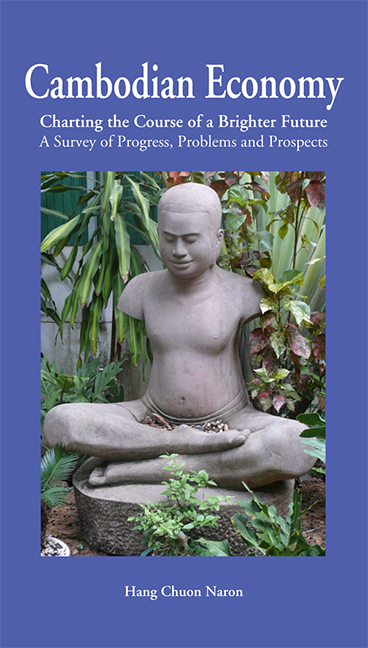 Cambodian Economy
Cambodian Economy from PART VI - HUMAN RESOURCE DEVELOPMENT
Published online by Cambridge University Press: 21 October 2015
At the end of the Khmer Rouge regime the entire population of Cambodia was living below the poverty line. Economic liberalization in the 1990s returned normalcy to the country and development over more than two decades has improved the poverty situation. Poverty receded from 43% in 1993/94 to 30% in 2007.
Dimensions and Characteristics of Poverty
17.1.1. Updating the Poverty Line
Cambodia's poverty lines consist of a single national food poverty line (based on an unchanging reference food bundle) and three region-specific nonfood allowances. The Cambodia poverty lines are expressed as daily per capita levels of food and nonfood consumption in the current prices of each region (i.e., Phnom Penh, Other Urban and Rural).
17.1.1.1. Updated Food Poverty Lines
The food poverty lines for each region are based on the estimated cost of consuming a single national reference food bundle providing an average subsistence diet of 2,100 calories per day (i.e., averaged over persons of all ages and both sexes). A three-step procedure was used to update the 2004 food poverty lines to 2007: (1) use the village food price data collected in the CSES in all three regions (i.e., Phnom Penh, Other Urban, Rural) and the quantity weights from the 1993/94 baseline reference food bundle to estimate spatial (regional) differences in food prices in 2004 and 2007, (2) estimate food price inflation in Phnom Penh using price data from the Phnom Penh CPI and quantity weights from the 1993/94 baseline reference food bundle, and (3) combine the temporal price index for Phnom Penh with the spatial price index to obtain temporal price indices for the remaining two regions.
Poverty line is defined as the income threshold below which the household (or individual) is considered poor. The individual poverty line set by the government is based on the consumer expenditure necessary to obtain 2,100 food calories a day, plus a minimum of non-food items computed according to the level of development of the commune.
To save this book to your Kindle, first ensure [email protected] is added to your Approved Personal Document E-mail List under your Personal Document Settings on the Manage Your Content and Devices page of your Amazon account. Then enter the ‘name’ part of your Kindle email address below. Find out more about saving to your Kindle.
Note you can select to save to either the @free.kindle.com or @kindle.com variations. ‘@free.kindle.com’ emails are free but can only be saved to your device when it is connected to wi-fi. ‘@kindle.com’ emails can be delivered even when you are not connected to wi-fi, but note that service fees apply.
Find out more about the Kindle Personal Document Service.
To save content items to your account, please confirm that you agree to abide by our usage policies. If this is the first time you use this feature, you will be asked to authorise Cambridge Core to connect with your account. Find out more about saving content to Dropbox.
To save content items to your account, please confirm that you agree to abide by our usage policies. If this is the first time you use this feature, you will be asked to authorise Cambridge Core to connect with your account. Find out more about saving content to Google Drive.